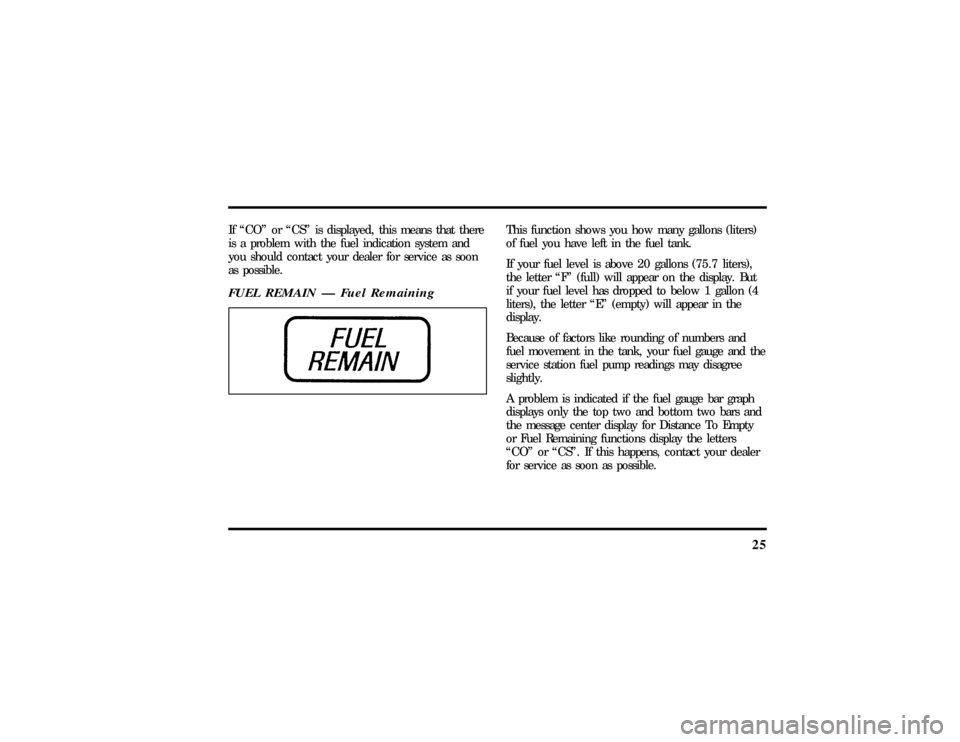Page 23 of 305
18The fuel gauge symbols indicate the remaining fuel:
ªFº means full, ª1/2º means half-full and ªEº
means empty.
Low fuel alertWhen the fuel level drops to approximately 1/8 of
a tank, a flashing fuel pump symbol is displayed.
If you want to calculate fuel economy, use the
message center buttons instead of the fuel gauge bar
graph indicator. It is likely to give you a much
more accurate figure.
NOTE:At least 2.5 gallons (9.5 liters) of fuel must
be added for the fuel gauge to immediately show
the next level of fuel. If less than 2.5 gallons (9.5
liters) of fuel is added, the gauge will reach the
new level slowly.
File:03fnist.ex
Update:Mon Jun 17 13:46:47 1996
Page 30 of 305

25
If ªCOº or ªCSº is displayed, this means that there
is a problem with the fuel indication system and
you should contact your dealer for service as soon
as possible.FUEL REMAIN Ð Fuel Remaining
This function shows you how many gallons (liters)
of fuel you have left in the fuel tank.
If your fuel level is above 20 gallons (75.7 liters),
the letter ªFº (full) will appear on the display. But
if your fuel level has dropped to below 1 gallon (4
liters), the letter ªEº (empty) will appear in the
display.
Because of factors like rounding of numbers and
fuel movement in the tank, your fuel gauge and the
service station fuel pump readings may disagree
slightly.
A problem is indicated if the fuel gauge bar graph
displays only the top two and bottom two bars and
the message center display for Distance To Empty
or Fuel Remaining functions display the letters
ªCOº or ªCSº. If this happens, contact your dealer
for service as soon as possible.
File:03fnist.ex
Update:Mon Jun 17 13:46:47 1996
Page 32 of 305
27
AVG ECON Ð Average Fuel EconomySelect this function to display your average fuel
economy in miles per gallon or liters per 100
kilometers. Your message center computes this
figure using the distance traveled and fuel used
information. If you want to reset this function, press
the RESET button while the average fuel economy
feature is displayed.
If you calculate your average fuel economy by
dividing miles traveled by gallons used, your figure
may be different than displayed because of:q
Your vehicle not being perfectly level during
fill-up
q
Differences in the automatic shut-off points on
the fuel pumps at service stations
q
Variations in top-off procedure from one fill-up
to another
q
Rounding of the displayed values to the nearest
0.1 gallon (liters) on the fuel gauge.
File:03fnist.ex
Update:Mon Jun 17 13:46:47 1996
Page 166 of 305

163
For a warm engine:
q
Do not hold the key in the START position for
more thanfive (5) secondsat a time. If the
engine does not start within five (5) seconds on
the first try, turn the key to the OFF position.
Wait a few seconds after the starter stops, then
try again.
Whenever you start your vehicle, release the
key as soon as the engine starts. Excessive
cranking could damage the starter.
After you start the engine, let it idle for a few
seconds. Keep your foot on the brake pedal and
put the gearshift lever in gear. Release the
parking brake. Slowly release the brake pedal
and drive away in the normal manner.
NOTE:Your vehicle has an interlock that
prevents you from shifting out of P (Park)
unless your foot is on the brake pedal.If the engine does not start after two
attempts:
1. Turn the ignition key to the OFF position.
2. Press the accelerator all the way to the floor
and hold it.
3. Turn the ignition key to the START position.
4. Release the ignition key when the engine starts.
5. Release the accelerator gradually as the engine
speeds up.
If the engine still does not start, the fuel pump
shut-off switch may have been activated. For
directions on how to reset the switch seeFuel
Pump Shut-Off Switchin the index.
File:08fntot.ex
Update:Mon Jun 17 13:51:45 1996
Page 183 of 305
181
Roadside EmergenciesThe flashers work whether your vehicle is running
or not. The flashers work for up to two hours
when the battery is fully charged and in good
condition without draining the battery excessively. If
the flashers run for longer than two hours or if the
battery is not fully charged, the battery can be
drained.
If the Engine Cranks but Does
Not Start or Does Not Start After
a CollisionFuel Pump Shut-off SwitchIf the engine cranks but does not start even after a
small collision, the fuel pump shut-off switch may
have been actuated. The shut-off switch is a device
intended to stop the fuel pump when your vehicle
has been involved in a substantial jolt.
Once the shut-off switch is actuated, you must reset
the switch by hand before you can start your
vehicle. The switch is on the left side of the trunk.
File:10fnert.ex
Update:Thu Jun 20 15:16:36 1996
Page 262 of 305

261
Engineq
Start engine every 15 days. Run at fast idle
until it reaches normal operating temperature.
q
With your foot on the brake, shift through all
the gears while the engine is running.
Fuel systemq
Fill fuel tank with high-quality, premium
unleaded fuel until the first automatic shutoff of
the fuel pump nozzle.
NOTE:During extended periods of vehicle storage
(60 days or more), fuel may deteriorate due to
oxidation. This can damage rubber and other
polymers in the fuel system and may also clog small
orifices.
Ford Gas Stabilizer should be added whenever
actual or expected storage periods exceed 60 days.
Follow the instructions on the label. The vehicle
should then be operated at idle speed to circulate
the additive throughout the fuel system.A volatile corrosion inhibitor added to the fuel
system will protect the fuel system's inner surfaces
from corrosion. Follow the instructions packaged
with the product.
Cooling systemq
Protect against freezing temperatures.
Batteryq
Check and recharge as necessary.
q
Keep connections clean and covered with a
light coat of grease.
q
If storing your vehicle for more than 30 days
without recharging the battery, disconnect the
battery cables to ensure battery charge is
maintained for quick starting. NOTE: If battery
cables are disconnected, it will be necessary to
reset any memory features (eg. radio presets).
File:12fncst.ex
Update:Thu Jun 20 15:16:56 1996
Page 291 of 305

300Driving under special conditions
heavy load............. 177
towing a trailer........... 179
E
Electrical system
circuit breakers........... 191
fuses................ 190
power point outlet.......... 73
Electronic sound system
antenna............... 40
tuning the radio........... 36
warranty and service information.... 53
Electronic stereo cassette radio
(see Electronic sound system)..... 35
Electronic stereo radio (see Electronic
sound system)............ 35
Emergencies, roadside
fuel................ 243
jump-starting............ 204
towing............... 209Emergency brake (parking brake)..... 168
Emission control system......... 246
catalytic converter.......... 246
emissions warranty........ 3,246
Engine
check engine warning light...... 14
does not start.........163, 181
fuel injected engine, starting...... 161
fuel pump shut-off switch....... 181
preparing to start........... 161
refill capacities............ 258
service points............ 216
starting............... 162
starting after a collision........ 181
storing your vehicle......... 260
Engine block heater........... 164
File:fnixt.ex
Update:Mon Jun 17 13:58:01 1996
Page 293 of 305

302Fuel
calculating fuel economy....... 244
capacity............... 258
choosing the right fuel........ 240
comparisons with EPA fuel
economy estimates......... 244
filling your vehicle with fuel...... 239
filter, specifications.......... 257
fuel filler door release lever...... 239
fuel gauge.............. 17
octane rating............ 241
quality............... 241
running out of fuel.......... 243
safety information relating to
automotive fuels.......... 242
storing your vehicle......... 261
treating emergencies......... 242
Fuel cap
removing.............. 239
replacing.............. 239Fuel filler door
remote release............ 239
Fuel filter, specifications......... 257
Fuel gauge............... 17
Fuel pump shut-off switch
engine does not start......... 181
starting after a collision........ 181
Fuse panels
engine compartment......... 187
instrument panel........... 190
Fuses
charts............185, 190
checking and replacing........ 190
circuit breakers........... 191
G
Gas cap (see Fuel cap).......... 239
Gas mileage (see Fuel economy)..... 244
Gasoline (see Fuel)........... 239
Gauges, Electronic
charging system gauge........ 15
engine coolant temperature gauge . . . 10
fuel gauge.............. 17
File:fnixt.ex
Update:Mon Jun 17 13:58:01 1996